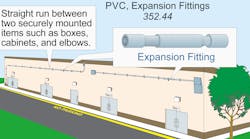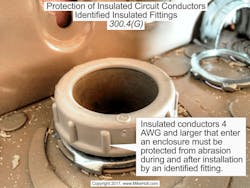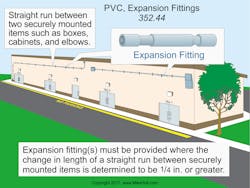Chapter 3 of the National Electrical Code (NEC) contains a series of Articles (342-376) that provide raceway requirements. The NEC defines a raceway as: “An enclosed channel designed expressly for holding wires, cables, or bus bars, with additional functions as permitted in this Code [Art. 100].”
Common rules
These rules apply to all types of raceway:
• The total amount of bends (including offsets) between pull points can’t exceed 360°.
• Remove burrs and rough edges after cutting.
• Install as a complete system.
• Securely fasten and support.
• Metallic raceway can serve as an equipment grounding conductor (EGC), provided it meets the requirements of Sec. 250.118, but nonmetallic raceway must include a separate EGC (wire type) [Sec. 362.60] when an EGC is required.
• Conductors 4 AWG and larger entering an enclosure must be protected from abrasion, during and after installation, by a fitting that provides a smooth, rounded, insulating surface (e.g., insulating bushing), unless the design of the box, fitting, or enclosure provides equivalent protection per Sec. 300.4(G) (Fig. 1).
What follows is an overview of two types of tubing; then two types of conduit.
Two tubing types
Electrical metallic tubing (EMT) is lightweight and relatively easy to bend and cut. Since it isn’t threaded, all connectors and couplings are threadless and provide quick, easy, and inexpensive installation when compared to conduit.
Electrical nonmetallic tubing (ENT) is a pliable, corrugated, circular raceway made of PVC. It’s available in many colors, and sold in fixed lengths and on reels.
EMT
You can use EMT exposed or concealed in [Sec. 358.10(A)]: (Fig. 2).
• Concrete in direct contact with the earth per Sec. 358.10(B).
• Dry, damp, or wet locations.
• Any hazardous (classified) location as permitted by other Articles in the Code.
You can use galvanized steel and stainless steel EMT, elbows, and fittings in concrete, in direct contact with the earth, or in areas subject to severe corrosive influences if protected by corrosion protection and approved as suitable for the condition [Sec. 300.6(A)].
You can’t use EMT [Sec. 358.12]:
(1) Where subject to severe physical damage.
(2) To support luminaires or other equipment (like boxes), except conduit bodies no larger than the largest trade size of the tubing the raceway can support.
Couplings and connectors
Couplings and connectors must be made-up tight to maintain an effective ground-fault current path to safely conduct fault current per Sec. 250.4(A)(5), Sec. 250.96(A), and Sec. 300.10 [358.42].
If buried in masonry or concrete, EMT fittings must be of the concrete-tight type. If installed in wet locations, fittings must be listed for use in wet locations and prevent moisture or water from entering or accumulating within the enclosure per Sec. 314.15.
ENT
You can use ENT [Sec. 362.10]:
(1) In buildings not exceeding three floors:
a. Exposed, where not prohibited by Sec. 362.12.
b. Concealed within walls, floors, and ceilings.
(2) In buildings exceeding three floors: concealed in walls, floors, or ceilings that provide a thermal barrier having a 15-min. finish rating, as identified in listings of fire-rated assemblies. If a fire sprinkler system is on all floors, per NFPA 13, you can use ENT in buildings of any height.
(3) In severe corrosive and chemical locations, when identified for this use.
(4) In dry and damp concealed locations, if not prohibited by Sec. 362.12.
(5) Above a suspended ceiling, if that ceiling provides a thermal barrier with a 15-min. finish rating, as identified in listings of fire-rated assemblies. If a fire sprinkler system is on all floors, per NFPA 13, you can use ENT above a suspended ceiling that doesn’t have a 15-min. finish rated thermal barrier.
(6) Where encased or embedded in a concrete slab, if using fittings identified for the purpose.
(7) In wet locations indoors, or in a concrete slab on or below grade, with fittings listed for the purpose.
You can’t use ENT [362.12]:
(1) In any hazardous location, except as permitted by Sec. 504.20 and Sec. 505.15(A)(1).
(2) For the support of luminaires or equipment. See Sec. 314.23.
(3) If the ambient temperature exceeds 50°C (122°F).
(4) For direct earth burial. But ENT can be encased in concrete [Sec. 362.10(6)].
(5) Exposed in buildings over three floors, except as permitted by Sec. 362.10(1) and (5), Exception.
(6) In assembly occupancies or theaters, except as permitted by Sec. 518.4 and Sec. 520.5.
(7) Exposed to the direct rays of the sun for an extended period, unless listed as sunlight resistant.
(8) If subject to physical damage.
Additionally, you can’t use ENT in ducts, plenum spaces [Sec. 300.22(C)], or patient care space circuits in health care facilities [Sec. 517.13(A)].
Joints
Make joints (e.g., couplings and connectors) in a manner approved by the Authority Having Jurisdiction (AHJ) [Sec. 362.48]. Follow the manufacturers’ instructions for the raceway, fittings, and glue.
Compare these conduits
Rigid metal conduit (RMC) is a standard choice for protection from physical impact and difficult environments.
Rigid PVC conduit provides many of the advantages of RMC, while allowing installation in areas that are wet or corrosive. It’s inexpensive, easily installed, lightweight, easily cut and glued together, and relatively strong. However, conduits manufactured from PVC are brittle when cold, and they sag when hot. It’s commonly used underground because of its low cost, ease of installation, and resistance to corrosion and decay.
RMC
You can use:
• Galvanized steel and stainless steel RMC in all atmospheric conditions and occupancies [Sec. 344.10(A)(1)].
• Red brass RMC for direct burial and swimming pool applications [Sec. 344.10(A)(2)].
• Aluminum RMC if approved for the environment [Sec. 344.10(A)(3)].
In corrosive environments [Sec. 344.10(B)]:
(1) Galvanized steel, stainless steel, and red brass RMC fittings, elbows, and couplings can be installed in concrete, in direct contact with the earth, or in areas subject to severe corrosive influences if approved for the condition.
(2) Aluminum RMC must have supplementary corrosion protection approved by the AHJ if encased in concrete or in direct contact with the earth.
In wet locations, support fittings such as screws and straps must be made of corrosion‑resistant material or protected by corrosion‑resistant coatings per Sec. 300.6 [Sec. 344.10(D)].
Thermal expansion
RMC must have expansion fittings if it’s necessary to compensate for thermal expansion and contraction [Sec. 300.7(B)]. Determine the expansion characteristics for:
• Steel raceways by multiplying the values from Table 352.44 by 0.20.
• Aluminum raceways by multiplying the values from Table 352.44 by 0.40 [300.7 Note].
Couplings and connectors
Couplings and connectors must be made-up tight to maintain an effective ground-fault current path to safely conduct fault current per Secs. 250.4(A)(5), 250.96(A), and 300.10. When installed in a wet location, they must comply with Sec. 314.15. [344.42(A)].
Threadless couplings and connectors cannot be used on threaded conduit, unless listed for the purpose.
PVC conduit
You can conceal PVC conduit within walls, floors, or ceilings, directly buried or embedded in concrete, in buildings of any height [Sec. 352.10(A)].
You can use PVC conduit in:
• Areas subject to severe corrosion for which the material is specifically approved by the AHJ [Sec. 352.10(B)].
• Wet or outdoor locations. The support fittings must be made of corrosion-resistant materials, or must be protected with a corrosion-resistant coating, per Sec. 300.6(A).
• Dry and damp locations, except where limited in Sec. 352.12.
• Exposed locations where not subject to physical damage. If exposed to physical damage, schedule 80 PVC is identified for the application.
• Underground installations, but it must comply with the burial requirements of Sec. 300.5.
PVC conduit can support nonmetallic conduit bodies that aren’t larger than the largest trade size of an entering raceway. These conduit bodies can’t support luminaires or other equipment, and cannot contain devices other than splicing devices permitted by Sec. 110.14(B) and Sec. 314.16(C)(2). You can’t use PVC conduit [352.12]:
• In hazardous locations except as permitted by Secs. 501.10(A)(1)(a) Exception, 503.10(A), 504.20, 514.8 Exception No. 2, and 515.8.
• In Class I, Div. 2 locations, except as permitted in Sec. 501.10(B)(7).
• For the support of luminaires or other equipment not described in Sec. 352.10(H).
Expansion fittings
If installing PVC conduit in a straight run between securely mounted items (e.g., boxes) provide expansion fittings if the expansion or contraction length change (per Table 352.44) is expected to be ¼ in. or greater [352.44] (Fig. 3). When determining the number and setting of expansion fittings, read the manufacturer’s documentation.
Raceway expertise
Chapter 3 provides the requirements for many different types of raceways, wireways, and cable systems. Selecting the right one for a given application makes a big difference in project cost, but also in system performance, safety, and reliability. It’s worth setting aside some time to compare them to learn the ways in which they differ.
Holt is the owner of Mike Holt Enterprises, Inc., Leesburg, Fla. He can be reached at www.mikeholt.com.







